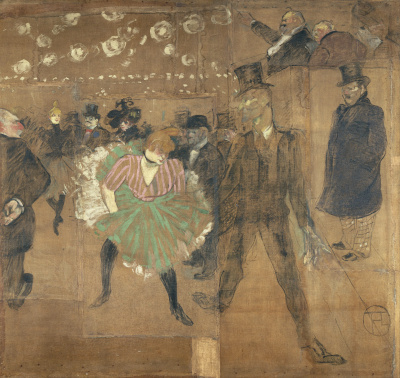This impressive painting was completed by Henri de Toulouse-Lautrec. The artwork today can be found at the Musée d'Orsay in Paris and its title loosely translates as Sign for the hut de la Goulue, at the Foire du Trône in Paris.
We find in front of us here a number of figures enjoying a nightout in Paris. Some look on from the sides, whilst other fill the dancefloor and enjoy themselves within the centre of the canvas. This huge piece is around three metres in width and height, making it one of the most ambitious artworks completed by this artist who would normally work on much smaller canvases. The artist was commissioned specifically to create two very large panels for La Goulue, with this being one of those. La Goulue was a dancer from the cabaret scene who by this stage was coming towards the end of her career and was well known to the artist, who spent a lot of his spare time in the company of performers from this environment. It is believed that another performer, Jane Avril, is featured at the back of this scene and she can be found in a number of figurative portraits also by this artist. Toulouse-Lautrec struggled to gain acceptance in some parts of society because of his physical issues, but here was entirely comfortable and so regularly attended cabaret nights in Montmartre.
Panneaux pour la baraque de la Goulue, à la Foire du Trône à Paris was a sign of loyalty to his friend, encouraging the performer to continue despite her coming towards the end of her career. Within this painting, which became damaged in the first few decades after it was completed, w we find a strong use of colour on the central dancer, with green stripes across her dress, and white tones underneath. She has pink vertical stripes across her upper half and auburn hair which the artist seemed to favour in his models. Most of the other figures are seen in black, reducing their significance to that of supporting figures, and some of the other tones would have faded due to their damage in any case. We find mainly men around the scene, dressed in top hats, with some in the stalls to the side. Excitement and energy seems to flood through this lively piece which captures the type of mood which encouraged the artist to spend so much time here.
The performer would appear again in La Goulue Entering the Moulin Rouge and also Moulin Rouge La Goulue. Toulouse-Lautrec liked to capture these performers both on stage, but also in more intimate, personal situations such as preparing for their performances just before they appeared. He liked the contrast between their act, and the real human that lie behind and was able to connect with their emotional side. He also showed loyalty and built good friendships with many people at this time, though eventually his long nightouts would catch up with his health.




